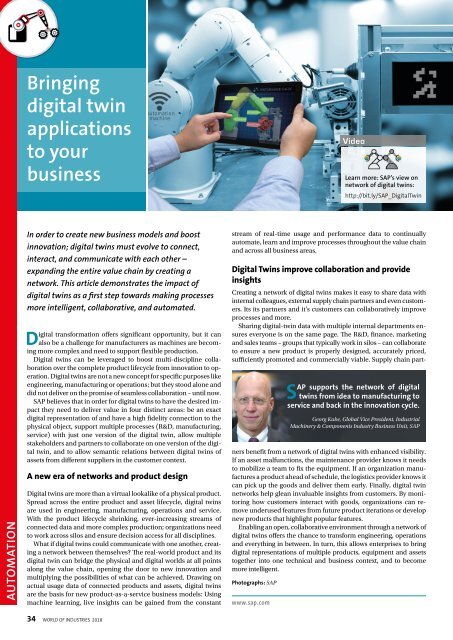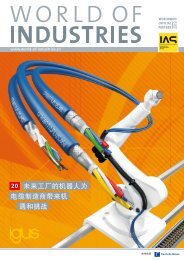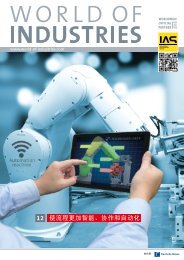WORLD OF INDUSTRIES 06/2018 (RU)
WORLD OF INDUSTRIES 06/2018 (RU)
WORLD OF INDUSTRIES 06/2018 (RU)
- No tags were found...
You also want an ePaper? Increase the reach of your titles
YUMPU automatically turns print PDFs into web optimized ePapers that Google loves.
Bringing<br />
digital twin<br />
applications<br />
to your<br />
business<br />
Video<br />
Learn more: SAP’s view on<br />
network of digital twins:<br />
http://bit.ly/SAP_DigitalTwin<br />
AUTOMATION<br />
In order to create new business models and boost<br />
innovation; digital twins must evolve to connect,<br />
interact, and communicate with each other –<br />
expanding the entire value chain by creating a<br />
network. This article demonstrates the impact of<br />
digital twins as a first step towards making processes<br />
more intelligent, collaborative, and automated.<br />
Digital transformation offers significant opportunity, but it can<br />
also be a challenge for manufacturers as machines are becoming<br />
more complex and need to support flexible production.<br />
Digital twins can be leveraged to boost multi-discipline collaboration<br />
over the complete product lifecycle from innovation to operation.<br />
Digital twins are not a new concept for specific purposes like<br />
engineering, manufacturing or operations; but they stood alone and<br />
did not deliver on the promise of seamless collaboration – until now.<br />
SAP believes that in order for digital twins to have the desired impact<br />
they need to deliver value in four distinct areas: be an exact<br />
digital representation of and have a high fidelity connection to the<br />
physical object, support multiple processes (R&D, manufacturing,<br />
service) with just one version of the digital twin, allow multiple<br />
stakeholders and partners to collaborate on one version of the digital<br />
twin, and to allow semantic relations between digital twins of<br />
assets from different suppliers in the customer context.<br />
A new era of networks and product design<br />
Digital twins are more than a virtual lookalike of a physical product.<br />
Spread across the entire product and asset lifecycle, digital twins<br />
are used in engineering, manufacturing, operations and service.<br />
With the product lifecycle shrinking, ever-increasing streams of<br />
connected data and more complex production; organizations need<br />
to work across silos and ensure decision access for all disciplines.<br />
What if digital twins could communicate with one another, creating<br />
a network between themselves? The real-world product and its<br />
digital twin can bridge the physical and digital worlds at all points<br />
along the value chain, opening the door to new innovation and<br />
multiplying the possibilities of what can be achieved. Drawing on<br />
actual usage data of connected products and assets, digital twins<br />
are the basis for new product-as-a-service business models: Using<br />
machine learning, live insights can be gained from the constant<br />
stream of real-time usage and performance data to continually<br />
automate, learn and improve processes throughout the value chain<br />
and across all business areas.<br />
Digital Twins improve collaboration and provide<br />
insights<br />
Creating a network of digital twins makes it easy to share data with<br />
internal colleagues, external supply chain partners and even customers.<br />
Its its partners and it’s customers can collaboratively improve<br />
processes and more.<br />
Sharing digital-twin data with multiple internal departments ensures<br />
everyone is on the same page. The R&D, finance, marketing<br />
and sales teams – groups that typically work in silos – can collaborate<br />
to ensure a new product is properly designed, accurately priced,<br />
sufficiently promoted and commercially viable. Supply chain partners<br />
benefit from a network of digital twins with enhanced visibility.<br />
If an asset malfunctions, the maintenance provider knows it needs<br />
to mobilize a team to fix the equipment. If an organization manufactures<br />
a product ahead of schedule, the logistics provider knows it<br />
can pick up the goods and deliver them early. Finally, digital twin<br />
networks help glean invaluable insights from customers. By monitoring<br />
how customers interact with goods, organizations can remove<br />
underused features from future product iterations or develop<br />
new products that highlight popular features.<br />
Enabling an open, collaborative environment through a network of<br />
digital twins offers the chance to transform engineering, operations<br />
and everything in between. In turn, this allows enterprises to bring<br />
digital representations of multiple products, equipment and assets<br />
together into one technical and business context, and to become<br />
more intelligent.<br />
Photographs: SAP<br />
www.sap.com<br />
SAP supports the network of digital<br />
twins from idea to manufacturing to<br />
service and back in the innovation cycle.<br />
Georg Kube, Global Vice President, Industrial<br />
Machinery & Components Industry Business Unit, SAP<br />
34 <strong>WORLD</strong> <strong>OF</strong> <strong>INDUSTRIES</strong> <strong>2018</strong>
















